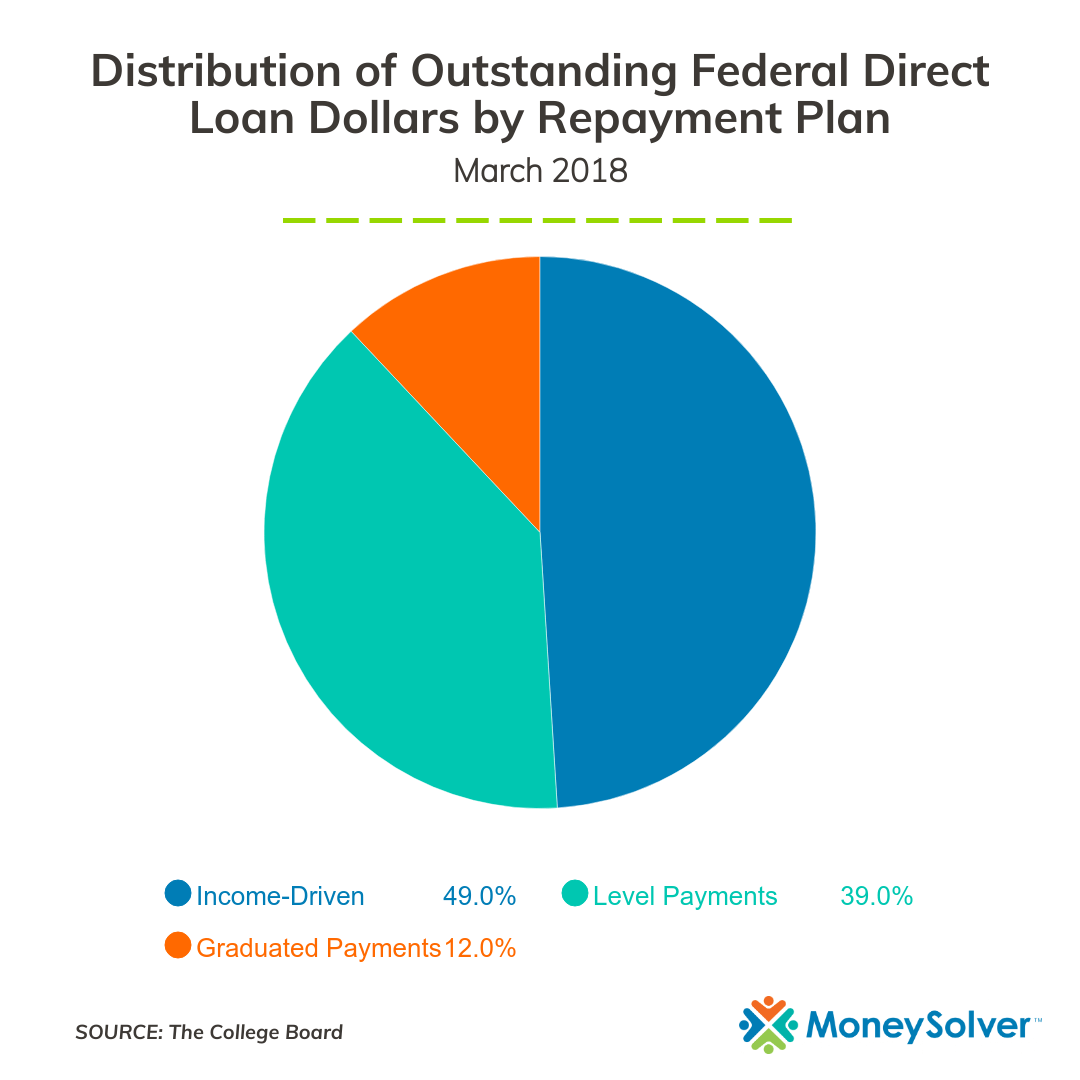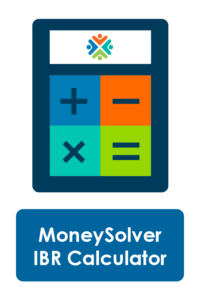11 Facts About Income-Based Repayment Student Loans
Struggling to afford your student loan bills? You’re not alone. There’s a reason the current state of U.S. student loan debt is currently a “crisis.” But what can you do to keep from contributing to the statistic of 40 percent of borrowers expected to default on their student loans by 2023? One way to make your payments more manageable is to get Income-Based Repayment student loans.
These student loan repayment plans allow you to pay based on how much you make instead of paying a standard rate that doesn’t take into account your income.
Want to see what your monthly payments could be on an income-based repayment plan?
Check out the MoneySolver income-based repayment calculator.
But before applying for an Income-Based Repayment plan, there are a few things you need to know to ensure it’s the right choice for you.
11 important facts about Income-Based Repayment Student Loans
1. Income-Based Repayment (IBR) is one of four Income-Driven Repayment (IDR) plans.
Sometimes, Income-Based Repayment (IBR) is incorrectly used as an umbrella term to describe all student loan repayment options determined by your income. The correct term for these plans is actually Income-Driven Repayment (IDR).
IDR plans are for people whose outstanding federal student loan debt makes up a significant part of their annual income. There are four income-driven plans:
- Revised Pay As You Earn Repayment Plan (REPAYE)
- Pay As You Earn Repayment Plan (PAYE)
- Income-Contingent Repayment Plan (ICR)
- Income-Based Repayment Plan (IBR)
Each of these plans has its own distinct features and qualifications. But the ultimate purpose of all these plans is to assist students who cannot afford their monthly payments under the Standard Plan.
With 49 percent of outstanding federal Direct student loan dollars being currently in IDR plans, these repayment plans are common amongst student loan borrowers.

2. IBR is the most common Income-Driven Repayment Plan.
Of the 28 percent of Direct Loan borrowers who have chosen an Income-Driven Repayment Plan, about over 40 percent are in the IBR plan.
Why is it more common than other income-driven plans? The IBR plan has slightly less strict requirements than PAYE, has been around longer than REPAYE, and offers lower payments than ICR.
3. Income-Based Repayment plans are only for federal student loans.
When discussing Income-Based Repayment student loans, we are only referring to the programs available for federal student loans.
Not all private student loan lenders offer IDR plans, so you’d have to talk with your lender to see if a similar option exists for you.
4. An IBR plan will lower your monthly payments.
The point of IBR student loans is to lower your payments if your income is low compared to your student loan balance. If you enroll in an IBR plan, your payments should become more manageable.
For new borrowers on or after July 1, 2014, IBR limits payments to 10 percent of your discretionary income.
For borrowers issued their first loans before July 1, 2014, IBR caps monthly payments to 15 percent of their discretionary income.
5. With Income-Based Repayment student loans, you can adjust payments when your family size or income changes.
Getting divorced, losing hours at work, or having a new baby? Life is always changing and your payments should reflect those major life changes.
You’re able to recertify your IBR plan to accommodate these changes. Your monthly payments will be recalculated accordingly.
This means your payments could be lowered to make things easier for you in this period of transition.
6. You can get student loan forgiveness with Income-Based Repayment student loans.
You can receive student loan forgiveness from the Department of Education through an Income-Based Repayment plan.
If you were a new borrower on or after July 1, 2014, you’ll get forgiveness after 20 years of repayment. If you got your first loan before July 1, 2014, you’ll receive forgiveness after 25 years of repayment.
You can also use an IBR to maximize the benefits of Public Service Loan Forgiveness (PSLF). Because PSLF forgives the remaining balance after 10 years of qualifying payments, enrolling in an IBR could help minimize your payments during that period of time.
Remember that forgiveness does have serious tax implications. Any forgiven debt under an IDR plan is taxable unless it’s through PSLF.
Make sure you discuss those sticky tax issues with a tax professional so you are prepared before you apply for an IBR plan.
7. Income-Based Repayment student loans take longer to repay.
Since IBR plans focus on lowering your monthly payments, they extend your repayment term. Instead of the standard 10 years, you could be paying off your student loans for 20 to 25 years.
This essentially doubles your time in debt, which isn’t ideal for everyone. The smaller your monthly payments, the longer you’ll be in debt.
The implications of more time in debt are important to consider. It could mean that you’ll still be paying off your student loans when your kids go to college. It could affect your ability to buy a home or car. You’ll need to be prepared for those consequences.
8. You’ll likely pay more in interest over time with an IBR plan.
Because you’ll be in repayment for an additional 10 to 15 years, more student loan interest will inevitably build over that time.
You’ll spend more over the life of the loan with this extra interest than you would have spent with a Standard Repayment Plan.
9. The balance of an IBR student loan could grow.
With that increased interest and longer repayment term, it’s possible that your loan’s remaining balance could grow instead of shrink. Large student loan balances can result in high monthly interest charges.
If you have an IBR plan, your monthly payments may not cover that accrued interest, which is referred to as “negative amortization.” With this specific income-driven plan, the government will pay all or some of the interest that isn’t covered by your monthly payment. This will only last for up to three consecutive years from when you began repaying your student loan under the IBR plan.
Once those three years are up, if you don’t continue qualifying for IBR or you leave the plan, any unpaid interest could be added to your balance and capitalized, ultimately building even more student loan debt.
10. You have to qualify for an IBR plan.
To qualify for an IBR plan, you have to be able to demonstrate partial financial hardship. Your potential IBR monthly student loan payments cannot equal or exceed your payments under the 10-year Standard Repayment Plan.
Keep in mind that your spouse’s income could disqualify you for an IBR plan. Your monthly payment will be based on your combined income and loan debt.
You also have to have a federal student loan that is eligible for IBR, which includes:
- Direct Subsidized and Unsubsidized Loans
- Direct Graduate PLUS Loans
- FFEL Consolidation Loans
- Direct Consolidation Loans
Those who have taken out Parent PLUS loans or any other type of federal loan made to parents cannot qualify for IBR. But if the Parent PLUS loans are consolidated, they could be considered for an ICR plan.
11. There’s paperwork that you have to complete to receive and keep an IBR plan.
To apply for an IBR plan, you’ll have to submit an IBR request form online or you can fill out a paper form from your loan servicer.
IBR plans also require your monthly payment to be recalculated every year. So every 12 months, you’ll have to take the time to recertify your income to keep your IBR plan. This will change your monthly payment based on your updated taxable income.
If you do not recertify your income on time, your IBR plan will be canceled. Your student loans will then revert to the Standard Repayment Plan.
Is Income-Based Repayment a good idea for you?
To see if an IBR plan is best for you and your student loans, you’ll want to make good use of an Income-Based Repayment calculator, like the MoneySolver IBR calculator. You can access this tool by clicking the image below. 
This income-based repayment student loan calculator can show you your potential monthly payment amount. It can also show you your new repayment term and potential for forgiveness. While lower monthly payments sound great, you should ensure that an IBR plan is the best option for you and your financial future.
Disclaimer: The viewpoints and information expressed are that of the author(s) and do not necessarily reflect the opinions, viewpoints, and official policies of any financial institution and/or government agency. All situations are unique and additional information can be obtained by contacting your loan servicer or a student loan professional.
